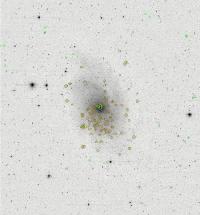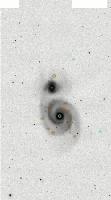
i. Large Galaxies
The XSC contains over 1.65 million galaxies and Galactic extended sources whose integrated fluxes are brighter than Ks < 13.5 mag (corresponding to roughly a S/N > 7). The XSC is complete for all galaxies larger than ~10´´ in diameter, including the largest galaxies in the sky. However, due to their proximity to a "scan" edge, galaxies larger than a few arcminutes will have photometry that is systematically incomplete. A typical 2MASS survey scan is 8.5´ × 6°, with 10% overlap between scans. Galaxies that are smaller than the overlap, D~50´´, are guaranteed to be fully sampled in at least one survey scan. Larger galaxies may be truncated, based on their proximity to a scan edge. Therefore it was necessary to construct an Atlas of Large Galaxies made from "pieces" of adjoining scans. The Atlas consists of galaxies ranging in size from 2´ to 2° (e.g., M31), with a typical spatial resolution of ~2-3´´ (with 1´´ pixels) in the 2MASS bands. The completed Atlas provides the aggregate flux for each galaxy and a detailed view of the near-infrared morphology. The Atlas is available to the public and can be accessed through the NASA Extragalactic Database (NED) and the Infrared Science Archive (IRSA). Positional, photometric and shape information from the Atlas are included in the XSC.
Sources in close proximity to large galaxies (selected from the LGA) are identified and flagged in the XSC cc_flg code (see IV.5.a.6). Their photometry is nulled in the final XSC catalog. Proximity is defined to be the area enclosed by the "Kron" radius, whose elliptical shape is given by the "super" coadd position angle and axis ratio. The Kron radius is further scaled by 1.1 to capture all sources affected by the large galaxy. Extended sources that are with 5% of the nominal center of the galaxy (as given by the LGA galaxy position and Kron radius) are identified as "matches" with the LGA and are to excised from the XSC.
Example: M33
The nearby galaxy M33 has many resolved features, including stars and HII regions that are detected by 2MASS. See the mosaic in the LGA for images of M33. The end result is a large amount of "chaff" in the XSC associated with M33. Figure 1 shows M33 (in the J-band) with extended sources marked in green, while red sources represent extended sources identified as being associated with M33. These sources remain in the XSC, but have their photometry nulled (since the background removal was not reliable for this large galaxy).

|
| Figure 1 |
White marked sources near the nucleus represent sources identified with the parent itself (M33 in this instance). These sources are purged from the XSC (since they are replaced by the LGA parent source). Notice that the extended sources (red marked) are in fact pieces of the M33 spiral arms. Also notice that the distribution is asymmetric from north to south (many more sources detected in the south). The asymmetry arises from that fact that the m33 nucleus was nearly cut in half by a coadd boundary (with the "southern" coadd having the nucleus), so the background removal in the 2MASS pipeline (GALWORKS) was, likewise, non-uniform -- each coadd had a separate solution for the background.
Example: M51
See the mosaic in the LGA for images of the M51 system. Figure 2 shows M51 and the marked sources, analogous to Figure 1.

|
| Figure 2 |
[Last Updated: 2004 Dec 21; by T. Jarrett & R. Cutri]